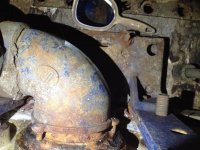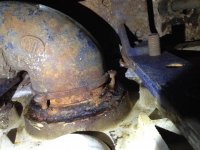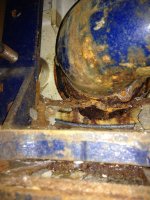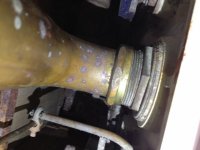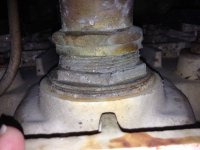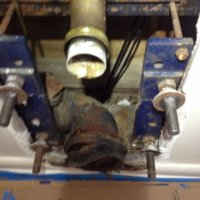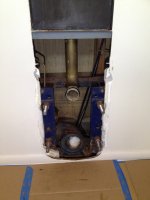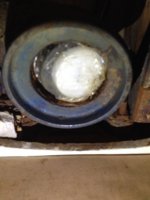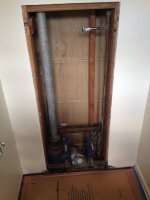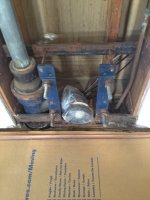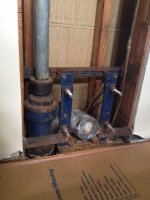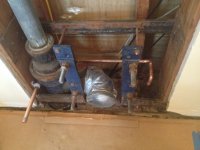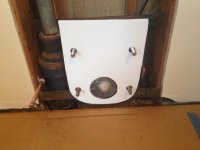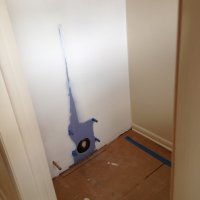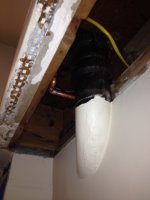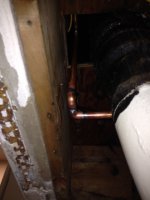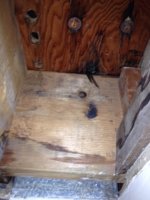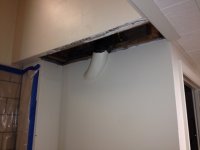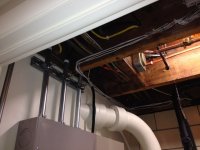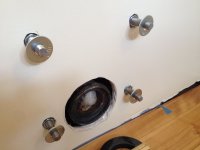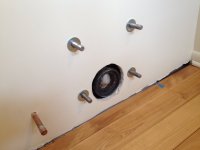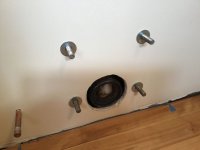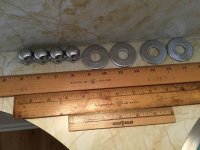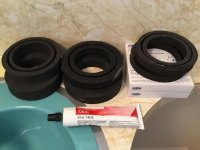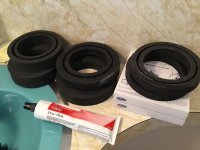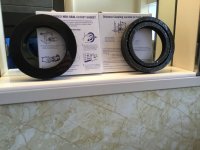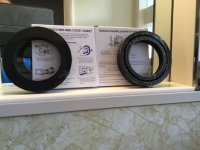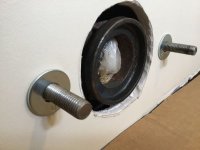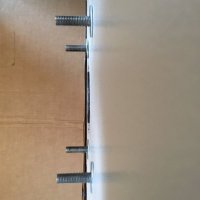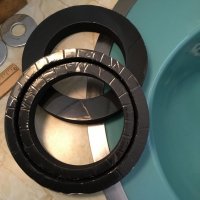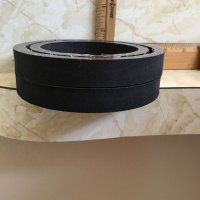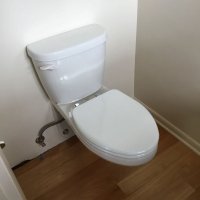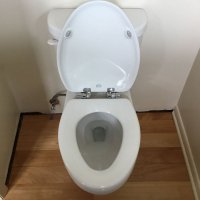Don in Ohio
New Member
Well, after faithfully working for more than 57 years, our 1959 wall-mounted Crane Walsan toilet in our powder room started leaking. The first clue was that the red birch floor under the bowl started cupping slightly. We searched for a leak, including behind the tank cover, and in the basement utility room's ceiling area below the powder room. Nothing seemed damp so we assumed (bad thing!) that it was just something that was a one-time problem. We even had the floor company that installed the floor stop by to give us a repair estimate (very $$$ for less than 10 square feet). We decided to wait and see if the boards would go back to normal after drying out totally.
A few weeks later, we discovered that the number of boards cupping was growing. We pulled the tank cover off, and after sticking my hand inside the tank cavity, I could feel a little water on the bottom of the bowl's outlet coupling to the 4" wall carrier (a Zurn-stamped ell that ties into a cast iron pipe junction with a cleanout plug and vent pipe connection). It appears that there is some rusty looking metal at the bottom of the ell, and when pulling up on the tank's flapper, there is water coming out of the area (though most goes down the drain). So it appears the leak occurs only when the toilet is flushed. This toilet is in a powder room that is seldom used (luckily), but the wife cleans and then flushes the toilet at least once per week. I have now shut off the water supply, drained the tank and bowl and have sealed the bowl with plastic sheeting and taped around the tank cover to minimize sewer gas.
At this point, our plumber (a master plumber who's done good work for us in the past) has taken a quick look at the toilet, and verified the leak occurs only when flushed. He's pretty busy at the moment, and we have 2 other working Crane Walsan units, so the powder room fix isn't an emergency situation. We discussed the options, one of which is to remove the Walsan bowl and see what the condition of the in-wall carrier is, and if the Walsan can simply be reused. He's not familiar with the Walsan so is concerned about disassembling the bowl's water inlet side, as these parts haven't been apart for more than 50 years, and replacement parts are not likely available. If the Walsan breaks beyond repair during the removal process, we would consider replacing it with the Gerber Maxwell.
Because of the small size of the powder room, and the fact that its door swings into the room, we want to retain a wall mounted toilet. The Gerber Maxwell would probably fit okay, although the door would open about 4" less than it currently does. It is reasonably priced and would suffice for use in our seldom-used powder room. I should also mention that there is no clearance to install a floor-mounted toilet in this room, as there is a floor joist directly below the powder room, and there are electrical lines, an electrical breaker box and an alarm control panel directly below as well.
Our major concern is that from the pictures I took (and have attached here), it looks like the existing Zurn ell may possibly be too rusted out to be reused for either the Walsan or a Gerber Maxwell. If we're faced with having to replace the wall carrier with a new one, I think we would prefer to undertake installing a Geberit in-wall carrier, and a new wall-mounted bowl to work with it. (This is the wife's 1st choice!) This will require mining out the old cast iron stack, redoing the steel vent pipe, relocating the water supply and of course, all the associated cement board, plaster, painting work. I don't take any of this lightly, but I only want to tackle this project once (I'm retired and am tired of being tied up with endless household projects!).
All that said, the pictures attached should help illustrate the situation. I'd like to start taking things apart, but have a few questions. Should I spray the existing brass nuts on the Walsan water inlet connection with something like PB Blaster and let it soak in for a few days, to help ensure I can loosen these parts up more easily? Once the bowl inlet pipe is removed (or at least the brass nuts are loosened), and the flush handle linkage is disconnected, will removing the 4 large cap nuts on the Walsan bowl be sufficient to loosening up the bowl from the sealing rings on the wall carrier (both the inlet and outlet sides)? I suspect the bowl will not be lightweight. Is pulling it away from the wall a two-person job? I don't need a hernia at this point in my life, nor would I want to experience it dropping onto my foot!
I sincerely appreciate the sage advice from the plumbing experts on this forum. Thanks for helping me make this project a successful one! I'll post the "after" pictures when it's finished!
A few weeks later, we discovered that the number of boards cupping was growing. We pulled the tank cover off, and after sticking my hand inside the tank cavity, I could feel a little water on the bottom of the bowl's outlet coupling to the 4" wall carrier (a Zurn-stamped ell that ties into a cast iron pipe junction with a cleanout plug and vent pipe connection). It appears that there is some rusty looking metal at the bottom of the ell, and when pulling up on the tank's flapper, there is water coming out of the area (though most goes down the drain). So it appears the leak occurs only when the toilet is flushed. This toilet is in a powder room that is seldom used (luckily), but the wife cleans and then flushes the toilet at least once per week. I have now shut off the water supply, drained the tank and bowl and have sealed the bowl with plastic sheeting and taped around the tank cover to minimize sewer gas.
At this point, our plumber (a master plumber who's done good work for us in the past) has taken a quick look at the toilet, and verified the leak occurs only when flushed. He's pretty busy at the moment, and we have 2 other working Crane Walsan units, so the powder room fix isn't an emergency situation. We discussed the options, one of which is to remove the Walsan bowl and see what the condition of the in-wall carrier is, and if the Walsan can simply be reused. He's not familiar with the Walsan so is concerned about disassembling the bowl's water inlet side, as these parts haven't been apart for more than 50 years, and replacement parts are not likely available. If the Walsan breaks beyond repair during the removal process, we would consider replacing it with the Gerber Maxwell.
Because of the small size of the powder room, and the fact that its door swings into the room, we want to retain a wall mounted toilet. The Gerber Maxwell would probably fit okay, although the door would open about 4" less than it currently does. It is reasonably priced and would suffice for use in our seldom-used powder room. I should also mention that there is no clearance to install a floor-mounted toilet in this room, as there is a floor joist directly below the powder room, and there are electrical lines, an electrical breaker box and an alarm control panel directly below as well.
Our major concern is that from the pictures I took (and have attached here), it looks like the existing Zurn ell may possibly be too rusted out to be reused for either the Walsan or a Gerber Maxwell. If we're faced with having to replace the wall carrier with a new one, I think we would prefer to undertake installing a Geberit in-wall carrier, and a new wall-mounted bowl to work with it. (This is the wife's 1st choice!) This will require mining out the old cast iron stack, redoing the steel vent pipe, relocating the water supply and of course, all the associated cement board, plaster, painting work. I don't take any of this lightly, but I only want to tackle this project once (I'm retired and am tired of being tied up with endless household projects!).
All that said, the pictures attached should help illustrate the situation. I'd like to start taking things apart, but have a few questions. Should I spray the existing brass nuts on the Walsan water inlet connection with something like PB Blaster and let it soak in for a few days, to help ensure I can loosen these parts up more easily? Once the bowl inlet pipe is removed (or at least the brass nuts are loosened), and the flush handle linkage is disconnected, will removing the 4 large cap nuts on the Walsan bowl be sufficient to loosening up the bowl from the sealing rings on the wall carrier (both the inlet and outlet sides)? I suspect the bowl will not be lightweight. Is pulling it away from the wall a two-person job? I don't need a hernia at this point in my life, nor would I want to experience it dropping onto my foot!
I sincerely appreciate the sage advice from the plumbing experts on this forum. Thanks for helping me make this project a successful one! I'll post the "after" pictures when it's finished!

